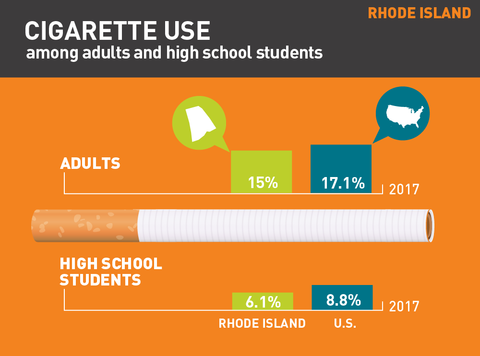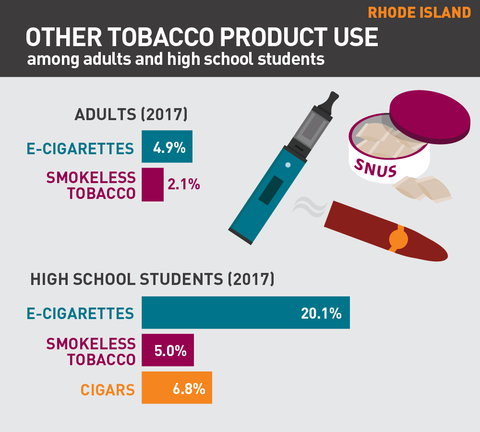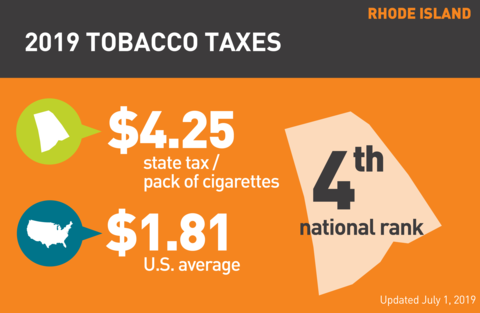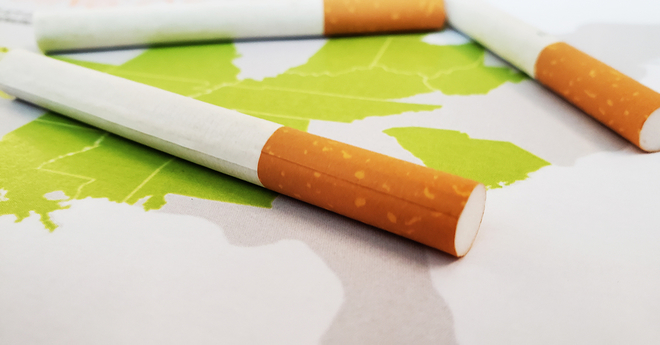Tobacco use in Rhode Island 2019
Cigarette use: Rhode Island
Cigarette use in Rhode Island
- In 2017, 15% of adults smoked. Nationally, the rate was 17.1%.1
- In 2017, 6.1% of high school students in Rhode Island smoked cigarettes on at least one day in the past 30 days. Nationally, the rate was 8.8%.2
Other tobacco product use: Rhode Island
E-cigarette and smokeless tobacco use in Rhode Island
- In 2017, 4.9% of adults used e-cigarettes and 2.1% used smokeless tobacco.3
- In 2017, 20.1% of high school students in Rhode Island used electronic vapor products on at least one day in the past 30 days. Nationally, the rate was 13.2%.2
- In 2017, 5.0% of high school students in Rhode Island used chewing tobacco, snuff or dip on at least one day in the past 30 days. Nationally, the rate was 5.5%.2
- In 2017, 6.8% of high school students in Rhode Island smoked cigars, cigarillos or little cigars on at least one day in the past 30 days. Nationally, the rate was 8.0%.2
Economics of tobacco use and tobacco control
Economics of tobacco use in Rhode Island
- Rhode Island received $195 million (estimated) in revenue from tobacco settlement payments and taxes in fiscal year 2019.4
- Of this, the state allocated $390,926 in state funds to tobacco prevention in fiscal year 2019, 3.1% of the Centers for Disease Control and Prevention’s annual spending target.4
- Smoking-caused health care costs: $640 million per year.4
- Smoking-caused losses in productivity: $458.9 million per year.5
Rhode Island tobacco laws
Cigarette tax in Rhode Island
Tobacco taxes
- Rhode Island is ranked 4th in the U.S. for its cigarette tax of $4.25 per pack (enacted August 2016), compared to the national average of $1.81. (The District of Columbia has the highest tax at $4.50 and Missouri has the lowest at 17 cents.)6-8
- Cigars, pipe tobacco products and smokeless tobacco, other than snuff, are taxed at 80% of the wholesale coast. The tax on cigars cannot exceed 50 cents per cigar.
- Snuff is taxed at $1 per ounce.6,7
Clean indoor air ordinances
- Smoking is prohibited in government workplaces, private workplaces, schools, childcare facilities, restaurants, bars (allowed in smoking bars), retail stores and recreational/cultural facilities.6,7
- Smoking restrictions are required in casinos/gaming establishments.6,7
- E-cigarettes are included in the state’s definition of smoking.9
Youth access laws
- The minimum age to purchase tobacco products in Rhode Island is 21. In December 2019, the United States adopted a law raising the federal minimum age of sale of all tobacco products to 21, effective immediately.
- Establishments are required to post signs stating that the sale of tobacco products to minors is prohibited.6
- Minors are prohibited from buying bidis and/or e-cigarettes.6
Local tobacco laws
- Two cities in Rhode Island, Barrington and Central Falls, have raised the minimum legal age to purchase tobacco products to 21.10
- Barrington, Central Falls, Johnston, Middletown, Providence and Woonsocket have banned the sale of flavored tobacco products, except menthol, mint and wintergreen. Smoking and hookah bars are exempt.11
- Barrington, Central Falls, Johnston, Middletown, Providence and West Warwick prohibit licensed tobacco vendors from selling discounted tobacco products through coupon redemption and multipack offers.10
Quitting statistics and benefits
Quitting statistics in Rhode Island
- The CDC estimates 54.6% of daily adult smokers in Rhode Island quit smoking for one or more days in 2017.3
- In 2014, the Affordable Care Act required that Medicaid programs cover all tobacco cessation medications.7**
- Rhode Island’s state quit line invests $1 per smoker, compared to the national average of $2.10.7
- Rhode Island has a private insurance mandate provision for cessation.7
Notes and references
Updated April 2019
*National and state-level prevalence numbers reflect the most recent data available. This may differ across state fact sheets.
**The seven recommended cessation medications are NRT gum, NRT patch, NRT nasal spray, NRT inhaler, NRT lozenge, Varenicline (Chantix) and Bupropion (Zyban).
Fiore MC, et al. Treating Tobacco Use and Dependence: 2008 Update. Clinical Practice Guideline. Rockville, MD: US Department of Health and Human Services. Public Health Service: May 2008.
1. CDC, Behavioral Risk Factor Surveillance System, 2017.
2. CDC, Youth Risk Behavior Surveillance System, 2017.
3. CDC, Behavioral Risk Factor Surveillance System, State Tobacco Activities Tracking and Evaluation System, 2017.
4. Campaign for Tobacco-Free Kids, Broken Promises to Our Children: a State-by-State Look at the 1998 State Tobacco Settlement 20 Years Later FY2019, 2018.
5. Campaign for Tobacco-Free Kids, Toll of Tobacco in the United States.
6. American Lung Association, State Legislated Actions on Tobacco Issues (SLATI).
7. American Lung Association, State of Tobacco Control, 2019.
8. Campaign for Tobacco-Free Kids. State Cigarette Excise Tax Rates & Rankings. https://www.tobaccofreekids.org/assets/factsheets/0097.pdf.
9. Public Health Law Center. U.S. E-Cigarette Regulation: 50-State Review. http://www.publichealthlawcenter.org/resources/us-e-cigarette-regulations-50-state-review.
10. Tobacco-Free Rhode Island. RI Local Tobacco Control Ordinances & Policies. 2018; http://tobaccofree-ri.org/local-ordinances.htm.
11. Campaign for Tobacco-Free Kids. States & Localities That Have Restricted the Sale of Flavored Tobacco Products. https://www.tobaccofreekids.org/assets/factsheets/0398.pdf.




